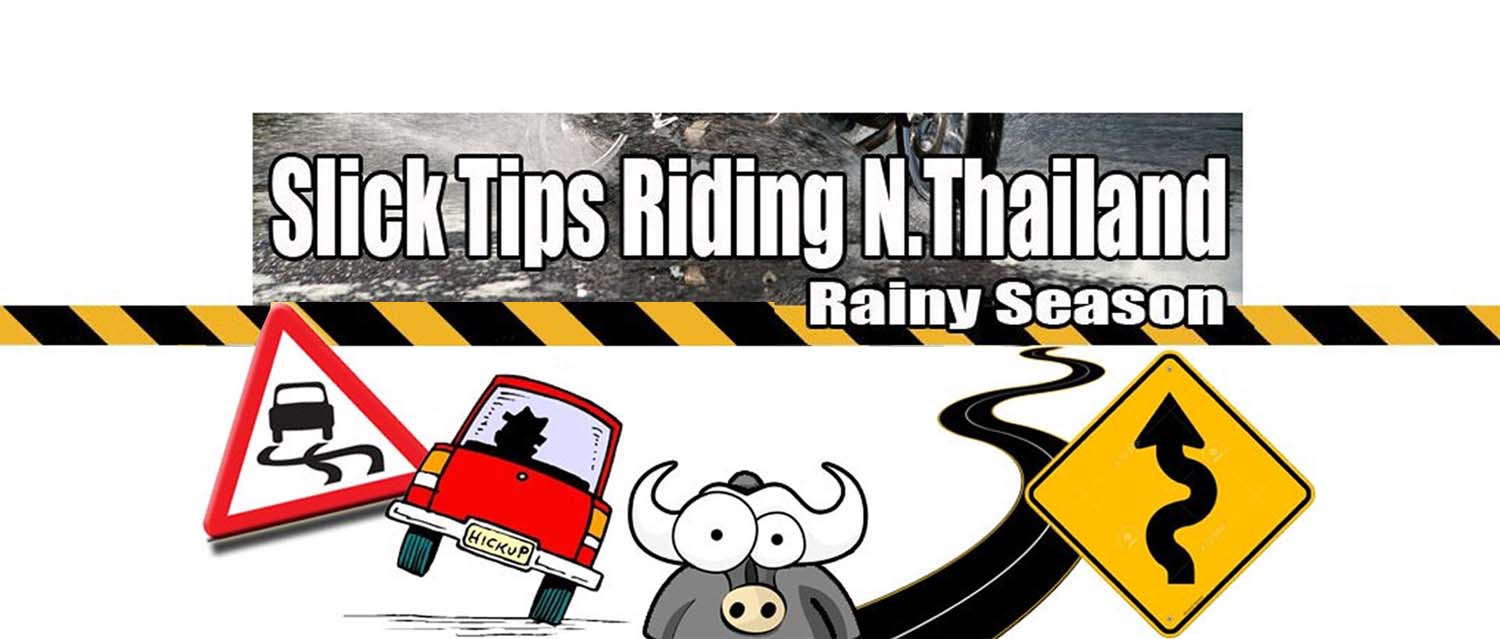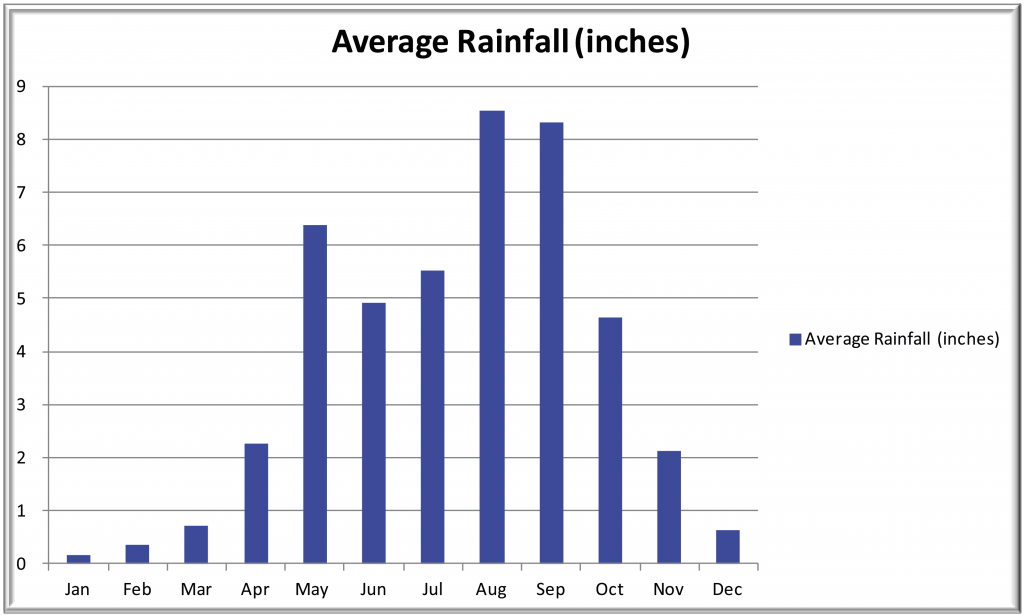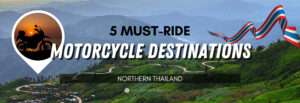
Tips for riding the Northern region during Rainy Season. (Rainy season – July to October).
Riding the Northern territory in Thailand during Rainy Season is the trickiest time you can ride in the region. Given that many of the roads are extremely twisty, with often poor conditions (such as polished surfaces, potholes and debris), the added rain poses some potentially serious risks. In fact, many riders even prefer to avoid riding during this time altogether. However, for me personally it is a season that I absolutely love. Nature just comes alive! So, if like me, you want to hit the road during Rainy Season in all it’s glory, here are some practical tips to help you.
Rainfall: (when does it rain? How much? How often?)

The Northern Regions share a fairly similar pattern of rainfall; sharp bursts followed by dry clear skies. There are days when the rain falls relentlessly, but normally only in the middle half of the Rainy Season. For most of the season the pattern is usually a burst of rainfall during the night and/or early morning, followed by a burst in the afternoon (usually sometime between 2 pm and 4 pm). In between these times, it is normally dry and clear. The afternoon showers often come in a series of bursts, so keep in mind when one rain shower has eased up another burst will likely come five minutes or so later.
Keep an eye on the direction of the rain clouds too, as this will help you gauge whether to take shelter or ride on through. Around mid-July and September, the rain tends to be heavier and last for longer periods, but by mid-October, the rains have pretty much eased off again as it comes to the end of the season.
When riding during Rainy Season, if you are properly prepared and comfortable, waiting out in the rain for the storm to pass is in my opinion, a lovely experience in itself.
Bike Setup:
A bit of “stating the obvious” here but mentioning “just in case”. Your bike should always be set up to perform at its best before any ride, regardless of weather conditions, but if there is any season where it is imperative to ensure your bike is set upright, it is this season.
The roads during rainy season amplify hazards and create new ones. The basics should be covered of course, such as checking tire pressure (In general I personally prefer a slightly softer tire with less air pressure which allows the tire to flex more, giving a less harsh ride on uneven road surfaces. But during Rainy Season I tend to stick to the book).
Also, make sure the chain is lubricated, double-check that your lights work, check your oil and brake fluid and importantly check the condition of your tires and brakes (and test their performance). If you want to ensure the best traction possible it is a good idea to change your tires to a set of rain tires (tires with deep grooves which channel water better).
Gear:

A decent set of rain gear is a must. Check that everything you will wear is waterproof/resistant. The last thing you want is to be wet and miserable.
When I ride during Rainy Season I keep my rain gear at the top of my topbox in order to grab it quickly when necessary. I generally take it off as soon as the weather has dried up so as not to overheat. Rainy season can often be very humid, so ensuring you don’t overheat is important. Rain gear also doubles up as a good windbreaker when riding in higher and cooler altitudes.
Your basic riding gear should include all the regular items such as armoured clothing and decent riding boots and gloves, and of course a good helmet.
If you aren’t already in Thailand it is best to bring rain gear over with you, as decent rain gear isn’t so easy to find. If you are already in Thailand then I recommend trying Helmet2Home in Chiang Mai for reasonably price protective rain gear.
Mainly rain gear in Thailand is poncho style or cheap and thin plastic coveralls, which is fine for city riding but not good for riding at speed.
Aquaplaning & Braking:
When riding during this season you should prepare yourself for the possibility of aquaplaning. For those that aren’t sure of what this is, aquaplaning is when your bike becomes unresponsive to steering, braking or accelerating and begins to skid or slide. If not handled correctly this could become a very dangerous situation.
Aquaplaning occurs when the water between your tires and the road surface isn’t removed from the tires quickly enough, resulting in a buildup of water which in turn causes the tire to lose contact and traction on the road. For this reason (as mentioned above) it is good to have rain tires that have deep grooves for channelling the water better.
In order to reduce the chances of aquaplaning it is important to check that your tire pressure is correct (if your tire pressures are too low or too high this will increase the risk of water gathering and aquaplaning). Check you have sufficient tread depth on your tires to allow water to channel easily. Reduce speed when you notice wet areas or areas of standing water or puddles, especially when turning corners.
If you do find yourself aquaplaning the first thing to do is realize what is happening and not panic about it. Where possible do not use your brakes and let off the accelerator. Focus your attention on steering to keep your bike on the road whilst allowing your bike to slow itself down. If you must brake then do so gently, with a slow pumping action. Many bikes are set up with ABS braking, but it is still good to rely upon your own instincts and braking than the ABS. Absolutely do not brake hard. Repeat: ABSOLUTELY do not brake hard!
Hazards:

Aside from the usual hazards one encounters on the roads in general, Thailand and Rainy Season have additional hazards to be mindful of:
Keep in mind that you will come across drivers that cut corners on sharp bends (I even had one minibus driver come at me from my side of the road on a narrow bridge! – Video clip of that incident HERE). Other hazards include bizarre ones such as random cattle sprawled over the road (don’t expect them to move, they won’t). Expect the unexpected and you will be covered. Hah!
If you haven’t ridden in Northern Thailand before then get familiar with the fact that in some areas the twisties really are VERY twisty, so set yourself up on a bend ready for the next bend/twist which can seemly come out of nowhere, particularly as there are many blind corners. Additionally, there are steep inclines and declines and off-camber corners, which can catch out even the most skilled of riders. Road surfaces vary so watch out for polished surfaces, oily debris and slippery road markings. Then there are additional possible hazards such as potholes.
Always keep a cloth handy for wiping your visor. The last thing you need is poor visibility. I read a good tip once which I have yet to try out, which was to stitch or attach a small piece of window-wiper rubber onto your glove. Then you can wipe away the rain when required easily.
Hope none of this is off-putting. I actually enjoy the challenges, providing I make it to my destination with no major dramas of course! Just good to be aware of what you may encounter.

Pros of riding in Northern Thailand during Rainy Season:
(no need to mention the cons as those are pretty obvious)
 You will get to see a lot of lush greenery plus a lot of amazing insects, fauna and flora. The scenery is breathtaking, particularly the mountain areas which are usually shrouded in interesting cloud cover. You will likely catch a lot of rainbows, sometimes double ones. (I have sadly still not found a crock of gold, despite my attempts and belief that I have found the end of the rainbow, but maybe one day…). The temperatures are usually very pleasant also, which is a bonus. Everywhere is cheaper too with regards to accommodation, as it is classed as low season. Activities (if interested) may also be cheaper (but be aware that certain activities and National Parks may be closed during this season).
You will get to see a lot of lush greenery plus a lot of amazing insects, fauna and flora. The scenery is breathtaking, particularly the mountain areas which are usually shrouded in interesting cloud cover. You will likely catch a lot of rainbows, sometimes double ones. (I have sadly still not found a crock of gold, despite my attempts and belief that I have found the end of the rainbow, but maybe one day…). The temperatures are usually very pleasant also, which is a bonus. Everywhere is cheaper too with regards to accommodation, as it is classed as low season. Activities (if interested) may also be cheaper (but be aware that certain activities and National Parks may be closed during this season).
If you have experience of riding during the rainy season would be great to know about your experiences or if you have any tips to add also.
Thanks for reading and hope it has been helpful.
Wish you all happy trails and safe riding!

3 Comments
Leave a Reply
You must be logged in to post a comment.




Great tips. Thanks.
Welcome Alex. Glad it helped! 😀
Fenders are not foolishness. If you plan on riding for any length of time, or with others, install fenders on both wheels. It will quadruple your comfort factor and keep your vision crystal clear. It’s one of the unspoken rules that on rainy-day group rides you should never show up without fenders. going to the “Active Advantage” section and clicking on the “do not renew” link towards the bottom of the page